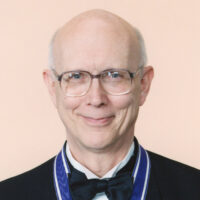
2003 Kyoto Prize Laureates
Materials Science and Engineering
/ Chemist
1939 -
Professor, Harvard University
All in the Family: The Human Side of Guiding Academic Research
2003
11 /11 Tue
Place:Kyoto International Conference Center
Self-Assembly of Organic Molecules and New Developments in Nanotechnology
2003
11 /12 Wed
10:30 - 17:30
Place:Kyoto international Conference Hall
With a broad perspective ranging from pure chemistry to materials engineering, Professor Whitesides has studied key processes by which organic molecules self-assemble on inorganic materials to form ultrathin film structures. Through the systematic investigation of the phenomena that take place on the interface between these materials, he has developed outstanding methods to control and utilize these self-assembly processes. In particular, he has demonstrated through a series of unique experiments that such technology can be used to form nanometer-scale functional materials. These efforts have opened a new domain of research in the field of nanomaterials based on organic molecules and have contributed greatly to the advancement of materials science as a whole.
With a broad perspective ranging from pure chemistry to materials engineering, Professor Whitesides has studied key processes by which organic molecules self-assemble on inorganic materials to form ultrathin film structures. Through the systematic investigation of the phenomena that take place on the interface between these materials, he has developed outstanding methods to control and utilize these self-assembly processes. In particular, he has demonstrated through a series of unique experiments that such technology can be used to form nanometer-scale functional materials. These efforts have opened a new domain of research in the field of nanomaterials based on organic molecules and have contributed greatly to the advancement of materials science as a whole.
Self-assembly is a process in which the molecules or atoms necessary to form a specific material or device assemble and align themselves naturally to form a desired structure. For example, in biological systems, self-assembly processes play key roles in the construction of proteins and membranes within the cells of living organisms. Scientists are exploring the possible applications of similar phenomena in the field of electronics.
Professor Whitesides paid special attention to the fact that hydrocarbon molecules with sulfur atoms at one end (organic thiolates, or alkanethiolates) easily absorb and align on gold and silver metal substrates, and he developed technologies to take advantage of the self-assembled monolayers (SAMs) formed during this process. Such monolayers, though but 1nm thick, are extremely stable; they can be used, for example, as protective resists on inorganic materials. They can be also employed as a surface layer on which to align and manipulate disparate organic or biological molecules, making them extremely important materials for the field of organic nanotechnology. Professor Whitesides worked not only with thiolate SAMs but also with combinations of a wide variety of substances. Using physicochemical methods, he carried out detailed assessments of molecular and atomic interactions and the self-assembly process in molecular ensembles, clarifying new possibilities for functional materials made of heterogeneous substances, such as organic molecules and metals.
Moreover, Professor Whitesides proposed and demonstrated the effectiveness of a new lithography method called Microcontact Printing (µ-CP), in which SAM patterns are fabricated using a microscopic stamp and transferred onto substrates. The conventional lithography technique, used widely in the production of integrated circuits, requires that a semiconductor surface be coated with a photosensitive organic film. Hence, its application for patterning other organic materials is almost impossible. However, the advent of this new method—known as soft lithography—has made possible the formation of complex microscopic patterns of organic materials. It also allows for the arrangement of proteins and other biological molecules according to specific patterns, making it applicable in the field of biotechnological devices. Expectations are especially high for the growth and broad potential applications of this technology in such areas as sensors, DNA chips, and protein analysis chips, which require the control and patterning of two-dimensional arrangements of biological molecules.
In this way, by focusing on the self-assembly process of organic molecules, Professor Whitesides has developed advanced technologies to employ monolayers for the fabrication of functional materials structures and has greatly increased our knowledge of the synthesis and fabrication of nano-scale materials. In addition, the new perspectives he has forged for the application of this technology represent a significant contribution to the field.
For these reasons, we are pleased to present the 2003 Kyoto Prize in Advanced Technology to Professor George McClelland Whitesides.
Profile is at the time of the award.